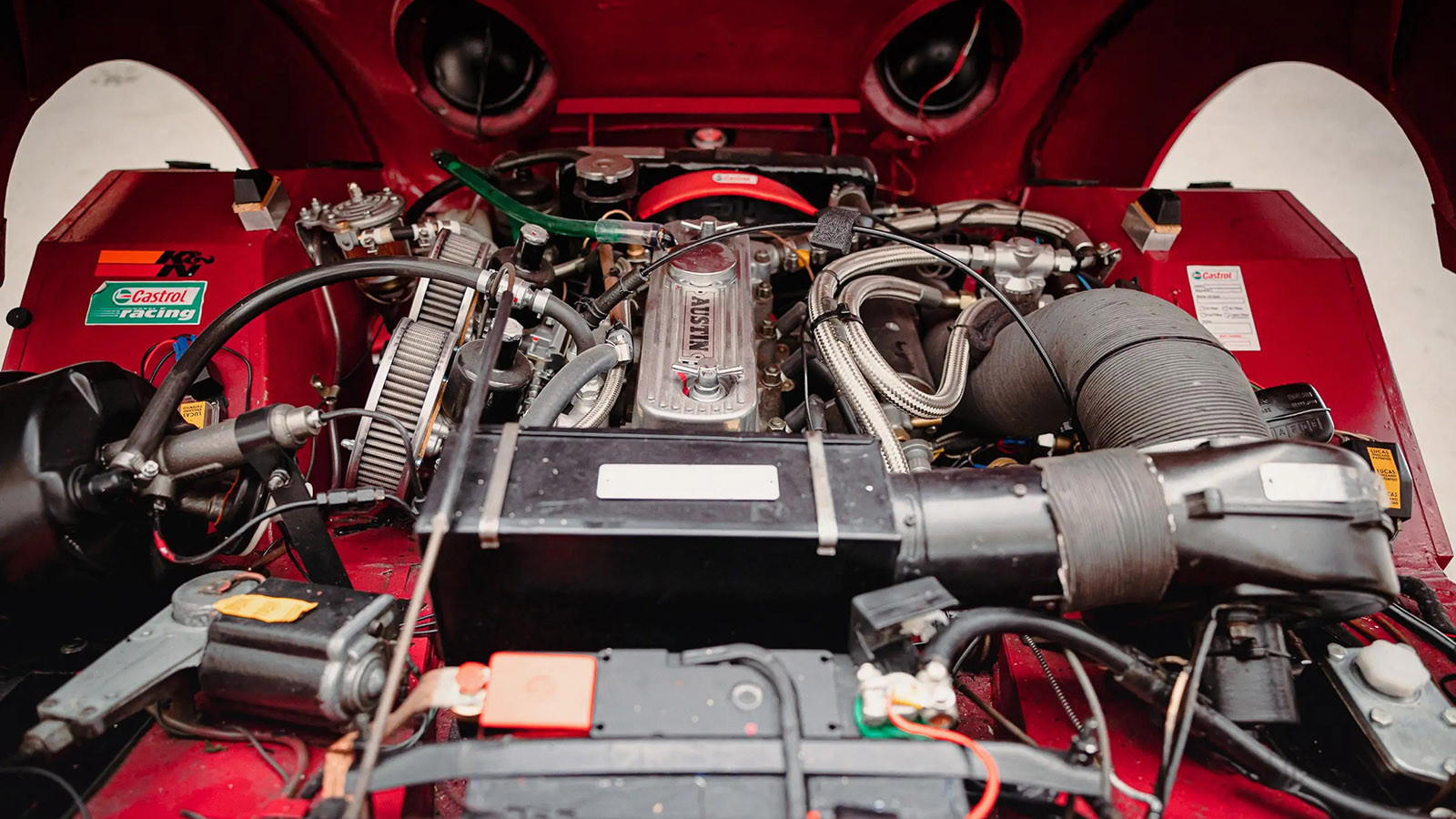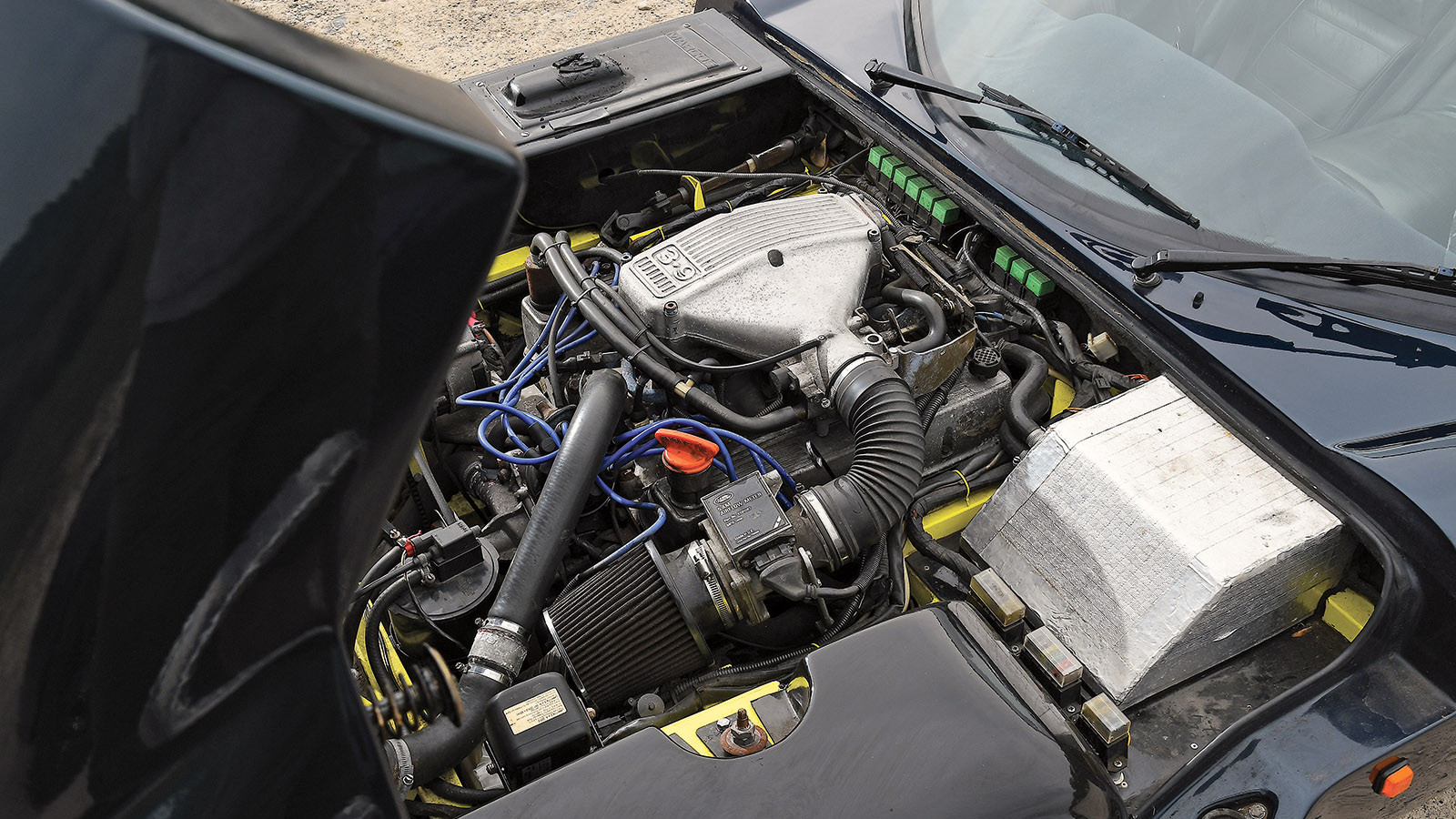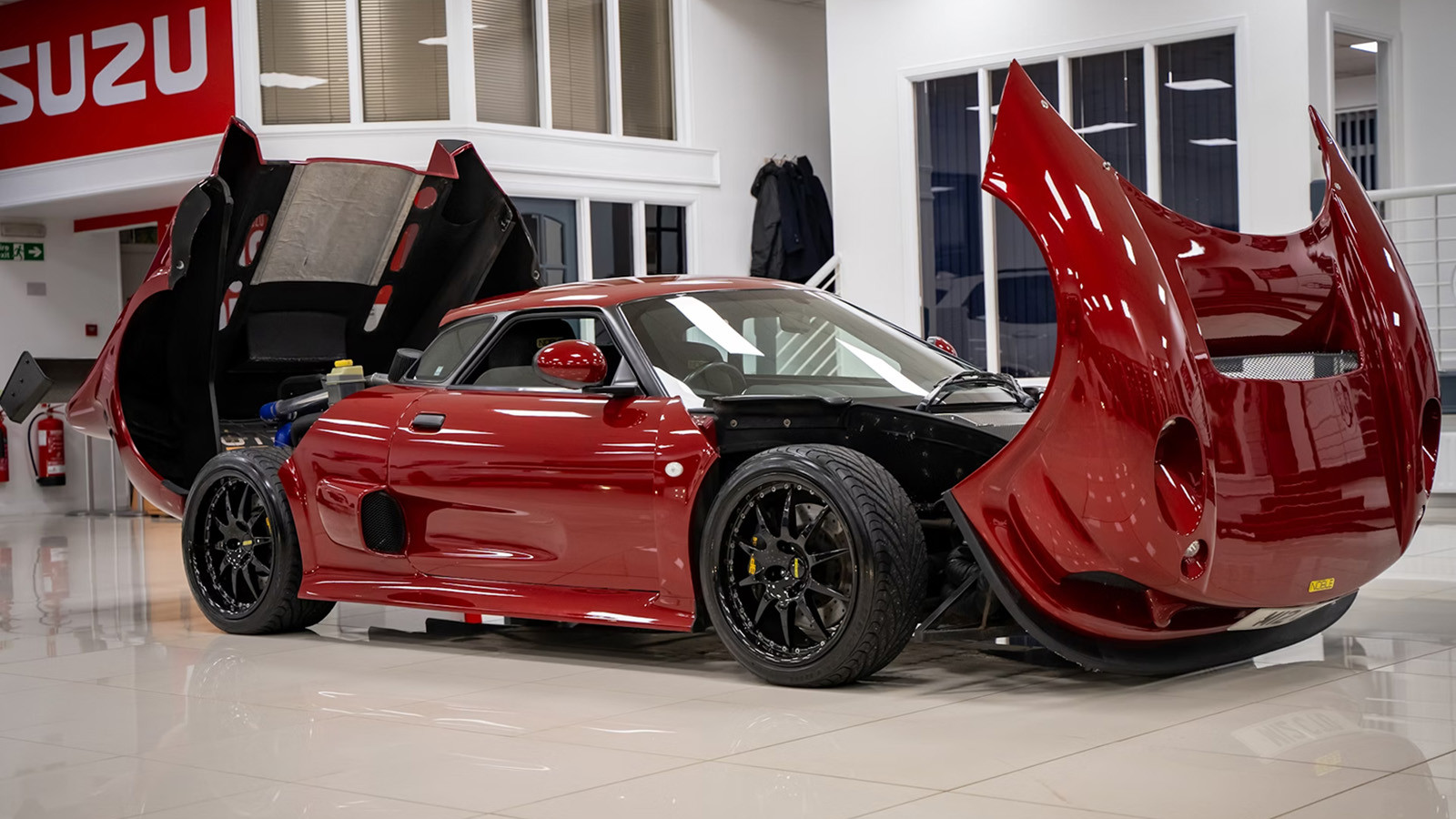-
 © Bring a Trailer
© Bring a Trailer -
 © Zach Brehl/Courtesy of RM Sotheby's
© Zach Brehl/Courtesy of RM Sotheby's -
 © Mitchell Curated
© Mitchell Curated -
 © Bonhams|Cars
© Bonhams|Cars -
 © Stellantis Media
© Stellantis Media -
 © Bonhams|Cars
© Bonhams|Cars -
 © Bonhams|Cars
© Bonhams|Cars -
 © Bring A Trailer
© Bring A Trailer -
 © Bonhams|Cars
© Bonhams|Cars -
 © Bonhams|Cars
© Bonhams|Cars -
 © Bonhams|Cars
© Bonhams|Cars -
 © Bonhams|Cars
© Bonhams|Cars -
 © Rasy Ran/RM Sotheby's
© Rasy Ran/RM Sotheby's -
 © Bonhams|Cars
© Bonhams|Cars -
 © Bonhams|Cars
© Bonhams|Cars -
 © Collecting Cars
© Collecting Cars -
 © John Bradshaw/Classic & Sports Car
© John Bradshaw/Classic & Sports Car -
 © Bonhams|Cars
© Bonhams|Cars -
 © Iconic Auctioneers
© Iconic Auctioneers -
 © Collecting Cars
© Collecting Cars -
 © Bring a Trailer
© Bring a Trailer
-
A different perspective
Cars with clamshell hoods are few and far between.
Some allow better access to the engine bay, but most are led from a design perspective.
Minimizing breaks in the bodywork creates a sleek appearance that’s hard to achieve with multiple pieces of the puzzle.
Instead, a clamshell helps the front of the car blend into a beautifully smooth sculpture of metal or fiberglass.
While there are even more front-hinged hoods that we could marvel at, for the purposes of this feature we’re looking at clamshells that incorporate the bodywork around the front wheelarches, and we’re showcasing 20 examples.
-
1. Jaguar XKSS
First we have the Jaguar XKSS, possibly not the Jaguar that’s most commonly associated with this hood style, but nonetheless an early example of the clamshell at work.
Based on the D-type, the XKSS was its roadgoing sibling which made use of unsold racing examples. A factory fire took nine of the 25 cars planned for production in 1957 so only 16 were made.
Given their rarity, XKSS models are extremely sought after and it’s unusual to see them change hands very often. This particular example achieved $13,205,000 at auction with RM Sotheby’s in 2023, complete with the registration JAG 1.
-
2. Lotus Eleven Series 2 Le Mans
Following the successful launch of the Lotus Eleven Series 1 with 150 models sold in a year, the Series 2 brought further profits to the company.
The Eleven embodied Colin Chapman’s lightweight philosophy, thanks to its aerodynamic design and aluminum bodywork.
Once owned and raced in period by Renato Bertorelli, the Lotus Eleven pictured here was converted to a GT spec with a fiberglass roof, gullwing doors and smaller wheelarches to show off the rims.
Its current owner (as of 2024), who’s been a custodian of the car since 1988, had it restored back to its original form and kept the roof.
Bertorelli enjoyed five years of racing across the UK at circuits such as Goodwood, Crystal Palace, Brands Hatch, Snetterton and Silverstone, before parting with this Eleven in 1967.
-
3. Austin-Healey Sprite
From the factory, the Austin-Healey Sprite featured a regular, rear-hinged hood, but over the years, converting it into a front-hinged clamshell version became quite popular with owners.
The rear-hinged configuration allowed little headroom under the hood to get at the engine.
Switching it to be front-hinged gave a much better vantage point for maintenance, while the tiny front overhang means the mechanism works seamlessly without scraping the nose along the ground.
-
4. Alfa Romeo 33 Stradale
Chasing after Alfa Romeo’s racing successes of the first half of the century, the firm came up with the 33 to revive its motorsport division.
The plan was to create a machine that was a worthy contender in the World Sportscar Championship. A fiberglass body was constructed so the car met the minimum weight requirements of 600KG (1322LB). Fewer breaks in the bodywork made it easier to keep weight down and mold an aerodynamic silhouette.
Everything went to plan and the 33 immediately drove to winning finishes.
This prompted the company to make a limited number of roadgoing versions with a few more creature comforts than the stripped-out racing variant.
The final product was an effortlessly elegant sculpture that stood just 39in (990mm) tall.
-
5. Ford GT40
Short, mid-engined racing cars were the height of fashion in the ’60s and the GT40 delivered on both fronts.
Just a fraction taller than the Alfa Romeo 33 Stradale, it was 40in (1016mm) high, hence the name. Originally Ford christened it the GT, but the nickname GT40 stuck and became its official moniker.
During development, Bruce McLaren was Ford’s test track driver and helped weed out any issues with pre-production models.
The team spent 10 months perfecting the recipe before time trials at Le Mans where it was established a large spoiler was needed to improve its handling at speed.
In 1966, a Ford GT40 Mk2 driven by McLaren and Chris Amon won the 24 Hours of Le Mans, beating Ferrari who had won the six previous editions.
-
6. Jaguar E-type/XK-E
Now we come to one of the most memorable uses of the clamshell hood.
Effortlessly stylish and sleek, the Jaguar E-type’s smooth lines are only achievable using this massive front-hinged hood (the E-type was sold as the XK-E in North America).
Over several iterations from 1961 to 1974, its instantly recognizable body shape remained, along with its extremely long nose.
-
7. Saab Sonett II
The first time Saab used the Sonett name it belonged to a car that looked like the lovechild of a Jaguar D-type and a Mk1 Austin-Healey Sprite.
Its second attempt at the model, in 1966, was a wedge-shaped design with a huge rear window that wrapped around the sides of the car.
The Sonett II was originally launched with a 841cc engine, but in 1967 this was swapped for a more powerful 1498 cc Ford Taunus V4, resulting in the Sonett V4.
A bulging hood was introduced with the new motor so it would fit in the engine bay. To preserve a clear line of sight for the driver, the bulge was slightly offset to one side.
While it was functional, it wasn’t a popular design choice, so the car was reworked in 1970 for the Sonett III. The final iteration of the Sonett was more angular and did away with the clamshell hood altogether.
-
8. Lamborghini Miura
The Lamborghini Miura is often credited as being the world’s first supercar and at the time it was the fastest ever production vehicle.
After it made its debut in 1966, it became a tastemaker for countless other outstanding cars, and with its front and rear clamshells open, the V12 engine is exposed behind the cabin.
The pictured example has been owned by a string of French owners and sold in Paris in 2024 for €954,500 (cUS$1,034,500). The most expensive Miura, at the time of writing, sold for £3,207,000 (cUS$4,084,700).
-
9. Marcos 3-Litre GT
Marcos was founded by Jem Marsh and Frank Costin in 1959. The two came together and took the first three letters of their surnames to form the Marcos brand.
In the war Frank Costin had worked on the de Havilland Mosquito, a combat aircraft that used a mostly wooden airframe. These principles were taken forward into his automobile manufacturing.
In 1963, the GT was unveiled at the Earls Court Motor Show and then in 1969 the 3-Litre GT (to use the British spelling) was launched. By this time, the wooden chassis was replaced with a steel structure.
The Marcos brand became characterized by quirky designs from Dennis Adams, most of which featured some sort of clamshell hood.
-
10. Triumph Vitesse
Triumph was particularly fond of a front-hinged hood.
As its name suggests, Vitesse was the performance version of the Herald which also features the same style of hood – and who doesn’t love a small car with ample power from a straight-six engine and a whiff of luxury?
The Vitesse was better-performing, 20% more expensive and less fuel efficient than the Herald, which is likely why that model outsold it by nearly 10-to-one.
-
11. Triumph GT6
The next Triumph on our list is the GT6, a model closely related to the Spitfire and Vitesse, that uses the same straight-six as in the Vitesse.
When new and today it is often referred to as a cut-price E-type (or XK-E), but this Spitfire GT was conceived as an MGB GT rival.
The Mk1 version, which ran from 1966 until 1968, was criticized for its handling characteristics in that it didn’t seem to control its power very well, so the rear suspension set-up was revised for the Mk2 variant.
The Mk3 GT6 launched in 1970 and sold in better numbers than the Mk2, with 13,042 units made before production ended in 1973.
-
12. Lancia Stratos HF
The wedge shape doesn’t exactly lend itself to the clamshell hood, but somehow the Lancia Stratos pulls it off.
Of course, the design mostly makes it easier to access the engine quickly, rather than fiddling about lifting a hood; it just flips out to reveal the all-important mechanics beneath.
The pictured car enjoyed a racing career from 1977 to 1984, competing in the 24 Hours of Daytona, 12 Hours of Sebring and 6 Hours of Watkins Glen.
-
13. Triumph Spitfire
You were waiting for this one, weren’t you?
The final Triumph on our list is, of course, the Spitfire. Launched in 1962 it was based on the Herald and created as a rival for the Austin-Healey Sprite.
In the same year, the MGB was revealed, resulting in a battle of the British manufacturers for the top spot as the best convertible sports car – we’ll leave it up to you to decide which one was the greatest, but the Spitfire was the only one to feature a clamshell hood from the factory.
The Triumph Spitfire was a great success and it stayed in production until 1980, with around 315,000 built.
-
14. TVR 3000S
The TVR 3000S was based on the 3000M which came equipped with a 3-liter Ford Essex V6, accessed by opening its clamshell hood – it also powered the coupe to 121mph and 0-60mph in 7.7 secs.
The 3000ML was the luxury version which added walnut veneer, Wilton carpets and a sunroof. In 1978, TVR released the convertible version, the company’s first-ever roadster.
In all, 258 examples of the 3000S were built, 67 of which were left-hand drive and 13 of which were a product of a collaboration with Broadspeed which saw the engine turbocharged, giving up to 140mph and slashing the 0-60mph time to 5.8 secs.
-
15. AM General Humvee
Created for pure utility, the Humvee is a monument to the practicality of the clamshell hood.
In 1983, AM General won an army contract to supply 55,000 Humvees over five years. Its official name was a High Mobility Multipurpose Wheeled Vehicle (HMMWV), so Humvee was a convenient nickname to make it easier to say.
As of 2012, 280,000 Humvees had been produced and the model has left tire tracks on six continents through various military agreements.
Its versatility means the Humvee has been equipped for countless different applications including single- and double-cab versions, medical units, weaponry carriers and tow trucks.
In its standard specification it can drive through up to 30in (762mm) of water or, with a fording kit attached, can tackle twice that.
-
16. Marcos Mantara
The Mantara was Marcos’ first type-approved model. Until 1992, Marcos had been selling its cars under kit-car regulations, so this was its first foray into proper manufacturing.
To do the V8 engine justice, Marcos updated the Mantula chassis to include a new suspension set-up based on the Ford Sierra, which used MacPherson struts in the front and independent rear suspension.
This meant the track was widened and the bodywork was stretched over the front to create bulging wheelarches.
-
17. Dodge Viper
The Dodge Viper made its debut as a concept at the 1989 Detroit auto show and production started three years later.
It was designed to be a no-frills sports car, straight to the point with its immense power, which came from an 8-liter V10 engine co-developed with Lamborghini – by the fifth generation this had become an 8.4-liter V10.
In its first generation the Viper was equipped with the bare minimum. There was no air conditioning, stability control, ABS, roof, or exterior doorhandles.
But none of that mattered, because it could reach 60mph in 4.2 secs, which was faster than a Chevrolet Corvette or Porsche 911 at the time.
-
18. TVR Cerbera Speed 12
This was the only Cerbera Speed 12 produced by TVR and for good reason.
The idea was to make a supercar to take on the McLaren F1 GTR, one that could eventually make it to Le Mans in the GT1 class.
The story goes that after two Cerbera Speed 6 straight-six engines were mashed together to create a 7.7-liter V12, the power was just too immense, thought to be somewhere around 960HP.
As well as being a track machine it was supposed to be a roadgoing car – after Peter Wheeler drove home in a prototype version, the project was axed.
Unfortunately, we never got to see the full racing potential of the Cerbera Speed 12, but in 2023 the sole example sold for a staggering £601,500 (cUS$765,700).
-
19. Noble M12
Built on a shoestring budget, everything went into the car so, like the M10 before it, there was no marketing budget to speak of when the Noble M12 was launched.
Thankfully, this supercar spoke for itself – it was reportedly written about by journalists in 50 countries.
Priced at a relatively affordable (in supercar terms) £44,950, the M12 was widely praised for being the ultimate driver’s car and the best value for performance out there.
Released in 2000 it was the first 21st-century-defining supercar which was brought to the market by a fairly unknown brand, given Noble was only founded in 1999.
The M12 survived until 2008 when founder Lee Noble left the company after selling Noble in 2006.
-
20. Ultima GTR
The last car on our list is another stunning supercar.
Famed for its track ability as well as straight-line pace, the Ultima GTR was a kit car, but also available fully built by the factory.
Owners could source whichever engine suited their needs, but Ultima recommended a Chevrolet V8.
It has a link to the car we’ve just seen, too: Lee Noble founded Ultima in 1983, before selling it to Ted and Richard Marlow in 1992.
After this, the GTR was born in 1999 with a goal to break records. Its accolades included: fastest 0-60mph time, 2.6 secs; fastest 0-100mph time, 5.3 secs; fastest 30-70mph time, 1.8 secs; fastest 100-0mph braking, 3.6 secs; and fastest 0-100-0mph time of 9.4 secs.
